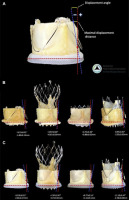当前位置:
X-MOL 学术
›
JACC Cardiovasc. Inte.
›
论文详情
Our official English website, www.x-mol.net, welcomes your feedback! (Note: you will need to create a separate account there.)
Bioprosthetic Valve Leaflet Displacement During Valve-in-Valve Intervention: An Ex Vivo Bench Study.
JACC: Cardiovascular Interventions ( IF 11.3 ) Pub Date : 2020-02-22 , DOI: 10.1016/j.jcin.2019.10.021 Mark Hensey 1 , Stephanie Sellers 1 , Janarthanan Sathananthan 1 , Althea Lai 1 , Uri Landes 1 , Abdullah Alkhodair 1 , Bruce McManus 1 , Anson Cheung 1 , David Wood 1 , Philipp Blanke 1 , Jonathon Leipsic 1 , Jian Ye 1 , John Webb 1
JACC: Cardiovascular Interventions ( IF 11.3 ) Pub Date : 2020-02-22 , DOI: 10.1016/j.jcin.2019.10.021 Mark Hensey 1 , Stephanie Sellers 1 , Janarthanan Sathananthan 1 , Althea Lai 1 , Uri Landes 1 , Abdullah Alkhodair 1 , Bruce McManus 1 , Anson Cheung 1 , David Wood 1 , Philipp Blanke 1 , Jonathon Leipsic 1 , Jian Ye 1 , John Webb 1
Affiliation

|
OBJECTIVES
The aim of this study was to examine the effect of different transcatheter heart valves (THVs) on valve leaflet displacement when deployed within bioprosthetic surgical valves and, thereby, risk for coronary obstruction.
BACKGROUND
Coronary obstruction is a potentially devastating complication during valve-in-valve (ViV) transcatheter aortic valve replacement. Strategies such as provisional stenting and intentional bioprosthetic valve leaflet laceration have been developed to mitigate this risk. Alternatively, the use of a THV that retracts the bioprosthetic leaflet away from the coronary ostium may prevent coronary obstruction.
METHODS
A 25-mm J-Valve, a 26-mm Evolut Pro, and a 23-mm JenaValve were implanted into both a 25-mm Trifecta surgical valve and a 25-mm Mitroflow surgical valve. A 23-mm and a 26-mm SAPIEN 3 were deployed into the Trifecta and Mitroflow, respectively. Displacement of the surgical valve leaflets (retraction vs. expansion) was measured with implantation of each THV by measuring displacement angle and maximal displacement distance.
RESULTS
Within both the Trifecta and Mitroflow valves, implantation of the J-Valve and JenaValve resulted in retraction of the surgical valve leaflets, and placement of the Evolut Pro and SAPIEN 3 resulted in tubular expansion of the surgical valve leaflets. There were significant differences in displacement angles and distances between both the J-Valve and JenaValve and the SAPIEN 3 and Evolut Pro (p < 0.0001).
CONCLUSIONS
ViV implantation with new-generation THVs that directly interact with bioprosthetic valve leaflets results in surgical valve leaflet retraction. This might mitigate the risk for coronary obstruction in selected cases of ViV transcatheter aortic valve replacement and also facilitate coronary reaccess after ViV TAVR.
中文翻译:

瓣膜内瓣膜介入手术期间的生物人工瓣膜小叶移位:体外实验研究。
目的本研究的目的是研究当在生物假体外科瓣膜内展开时,不同的经导管心脏瓣膜(THV)对瓣膜小叶移位的影响,以及由此而引起的冠状动脉阻塞风险。背景技术在瓣膜内瓣膜置换术中,冠状动脉阻塞是一种潜在的破坏性并发症。为了减轻这种风险,已经制定了一些策略,例如临时性支架置入和有意的生物瓣膜小叶裂伤。或者,使用THV可以将生物修复小叶从冠状动脉口收回,可以防止冠状动脉阻塞。方法将25毫米J阀,26毫米Evolut Pro和23毫米JenaValve分别植入25毫米Trifecta外科瓣膜和25毫米Mitroflow外科瓣膜中。将23毫米和26毫米的SAPIEN 3分别部署到Trifecta和Mitroflow中。植入每个THV时,通过测量位移角和最大位移距离来测量手术瓣膜小叶的位移(收缩与扩张)。结果在Trifecta和Mitroflow瓣膜中,J瓣膜和JenaValve的植入导致手术瓣膜小叶的缩回,而Evolut Pro和SAPIEN 3的放置导致手术瓣膜小叶的管状扩张。J阀和JenaValve与SAPIEN 3和Evolut Pro之间的位移角度和距离存在显着差异(p <0.0001)。结论ViV植入与生物瓣膜小叶直接相互作用的新一代THV可导致外科瓣膜小叶缩回。
更新日期:2020-02-27
中文翻译:

瓣膜内瓣膜介入手术期间的生物人工瓣膜小叶移位:体外实验研究。
目的本研究的目的是研究当在生物假体外科瓣膜内展开时,不同的经导管心脏瓣膜(THV)对瓣膜小叶移位的影响,以及由此而引起的冠状动脉阻塞风险。背景技术在瓣膜内瓣膜置换术中,冠状动脉阻塞是一种潜在的破坏性并发症。为了减轻这种风险,已经制定了一些策略,例如临时性支架置入和有意的生物瓣膜小叶裂伤。或者,使用THV可以将生物修复小叶从冠状动脉口收回,可以防止冠状动脉阻塞。方法将25毫米J阀,26毫米Evolut Pro和23毫米JenaValve分别植入25毫米Trifecta外科瓣膜和25毫米Mitroflow外科瓣膜中。将23毫米和26毫米的SAPIEN 3分别部署到Trifecta和Mitroflow中。植入每个THV时,通过测量位移角和最大位移距离来测量手术瓣膜小叶的位移(收缩与扩张)。结果在Trifecta和Mitroflow瓣膜中,J瓣膜和JenaValve的植入导致手术瓣膜小叶的缩回,而Evolut Pro和SAPIEN 3的放置导致手术瓣膜小叶的管状扩张。J阀和JenaValve与SAPIEN 3和Evolut Pro之间的位移角度和距离存在显着差异(p <0.0001)。结论ViV植入与生物瓣膜小叶直接相互作用的新一代THV可导致外科瓣膜小叶缩回。



























 京公网安备 11010802027423号
京公网安备 11010802027423号